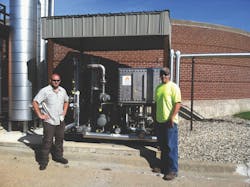Zero Sum
Danville, a city in Vermilion County, Ill., was founded in 1827 on 80 acres of land donated by two town fathers. It is located 120 miles south of Chicago and 90 miles west of Indianapolis. The city was named after one of the two land donors, Dan Beckwith and later became a heavily industrial city. From the 1850s to the 1940s, Danville was a major coal mining area; when the mines closed in the last half of the 20th century, they were converted into lakes for recreation.
The Plant’s History
The Danville Sanitary District (DSD) manages the city’s water and serves approximately 32,000 people. The DSD was created in 1935 under the 1917 Illinois Sanitary District Act, which provided for the creation of sanitary districts throughout the state. The plant was put into service in 1937 and at the time consisted of primary treatment with separate sludge digestion and a hydraulic capacity of 4.5 million gal per day (mgd). In 1957, secondary treatment was added with 8-mgd capacity. In 1967, activated sludge was added to the secondary treatment system. In 1974, additional secondary treatment was built, adding tertiary filtration, sludge incineration, chlorinating and the wet-weather plant. An excess-flow basin was built in 1983. The plant now is rated at 16 mgd with an overflow capacity to 24 mgd, according to Todd Lee, director of the DSD. The daily flow ranges from 5 mgd to 8 mgd.
Current Infrastructure
The DSD owns and operates about 37 miles of sanitary sewer in its collection system. There also are four lift stations. The city of Danville, which is a tributary to the DSD, owns and operates about 140 miles of sanitary sewer and 40 lift stations.
The main plant at the DSD has bar screening and grit removal at the headworks. There also is conventional primary treatment, conventional activated sludge secondary treatment and tertiary treatment through multimedia filters.
Depending on the time of year, the effluent is disinfected with chlorine and then the chlorine is removed with sulfur dioxide. Dissolved oxygen (DO) is added to the final effluent at a cascade structure and then discharged to the Vermilion River. Water typically will spend one day on the plant site going through the processes.
Sludge that drops out during primary treatment, as well as waste-activated sludge from the secondary treatment, is digested by anaerobic bacteria in the anaerobic digesters. After the sludge has been digested, it is stored in lagoons and is eventually land applied on farm fields, according to Thomas Stone, P.E., district engineer of the DSD. “It is a great fertilizer,” he said.
The excess flow plant handles flows that are greater than the main plant can handle. It has conventional primary treatment and a large storage basin and can hold about 10 mgd.
Plant Upgrades
The newest infrastructure at the DSD is the digester-gas-to-energy project, which was funded in part by the Illinois Department of Commerce and Economic Opportunity, which provided $200,000 for the project. The anaerobic digesters produce about 58,000 cu ft of digester gas per day. The primary component of this gas is methane. Prior to this project, the DSD’s practice was to flare this gas into the atmosphere. Currently, the DSD captures this gas, conditions it, and uses it for fuel in an engine that generates electricity for the plant and heat for the digesters so that they will generate more gas, according to Stone. “It’s sort of a circle of energy generation,” he said.
Previously, the DSD used about $1,000 per day in electricity and about $100 per day in natural gas. The digester-gas-to-energy project produces about $225 per day in electricity and saves about $80 per day in natural gas, which results in utility savings of more than $100,000 per year.
Future Plans
The next project, which recently was bid out, is the Aeration Energy Conservation Project. The Illinois Clean Energy Community Foundation is slated to provide $187,902 for this project. The Illinois Department of Commerce and Economic Opportunity also will provide significant funding, although the final amount has not yet been determined. This project includes new strip diffusers to replace ceramic stones in the aeration tanks and a new high-efficiency blower to provide the air for the aeration system. The new diffusers will produce a finer bubble, providing a more efficient oxygen transfer, and will have a lower head pressure, requiring less energy to pass an equivalent amount of air. The new blower will be more efficient because of frictionless bearings and its ability to ramp up and down with the oxygen demand.
Typically for wastewater treatment plants—and also true of the DSD—the aeration system for the secondary treatment consumes about half the total electrical energy used at the plant. The Aeration Energy Conservation Project is expected to cut the total cost of aeration in the secondary system in half. “After this project, we should be about halfway to being a net-zero treatment plant,” Stone said.
Another smaller project demonstrates the commitment that DSD personnel have made to energy conservation: The latest NPDES permit placed a minimum DO requirement on the district’s final effluent. “Several ideas were looked at; the one factor they had in common was that relatively high amounts of energy would be expended,” Stone said. “The maintenance and operations staff put their heads together and came up with the cascade structure. It was designed and built in house and when it was installed, the final effluent DO went up three points, enough to clear the permit requirement. It was truly a team effort.”
Other projects on the horizon include incorporating high-strength waste to generate more gas and bring on another digester-gas-to-energy assembly; conservation projects, especially involving pumps; and a solar energy project.
Download: Here
